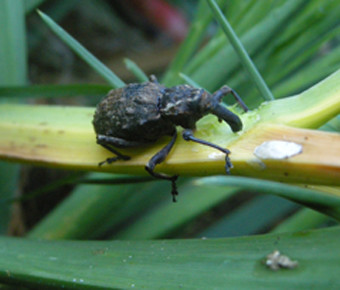 The speargrass weevil (Hadramphus spinipennis) is dependent on the speargrass, but can be locally very damaging: adults eat stems, flowers and leaves; larvae eat roots as well. Photographer: John Sawyer, Mangere May 2009.A famous paper generally known as “The world is green” (Hairston et al. 1960) stated that, under most circumstances, herbivores (including insects) are seldom food limited. That is, they do not exhaust the supply of green foliage. The situation with endangered plants is more complex because there are likely to be few situations where eruptive herbivores might totally defoliate and kill rare plants. In New Zealand the situation is even more difficult because there is a high degree of specificity between plants and their insect fauna. An endangered plant species is very likely to have one or more rare and endangered insects associated with it. An example is the threatened Chatham Islands Aciphylla dieffenbachii and the endangered rare weevil, Hadramphus spinipennis (see image below). The weevil larvae feed on the plant’s roots. The weevil stays within a patch of Aciphylla until it has so destroyed the root system that plants die. Adults then migrate to another patch and start all over again (Schops 1998). It is impossible to protect the plant from insect attack by insecticide spraying even with a relatively ‘soft’ insecticide like Neem oil.
The speargrass weevil (Hadramphus spinipennis) is dependent on the speargrass, but can be locally very damaging: adults eat stems, flowers and leaves; larvae eat roots as well. Photographer: John Sawyer, Mangere May 2009.A famous paper generally known as “The world is green” (Hairston et al. 1960) stated that, under most circumstances, herbivores (including insects) are seldom food limited. That is, they do not exhaust the supply of green foliage. The situation with endangered plants is more complex because there are likely to be few situations where eruptive herbivores might totally defoliate and kill rare plants. In New Zealand the situation is even more difficult because there is a high degree of specificity between plants and their insect fauna. An endangered plant species is very likely to have one or more rare and endangered insects associated with it. An example is the threatened Chatham Islands Aciphylla dieffenbachii and the endangered rare weevil, Hadramphus spinipennis (see image below). The weevil larvae feed on the plant’s roots. The weevil stays within a patch of Aciphylla until it has so destroyed the root system that plants die. Adults then migrate to another patch and start all over again (Schops 1998). It is impossible to protect the plant from insect attack by insecticide spraying even with a relatively ‘soft’ insecticide like Neem oil.
On the positive side, conservation of rare and threatened plants will almost certainly result in conservation of rare insect species. This may include undescribed species since only about half of New Zealand’s estimated 20,000 species of insect (Emberson 1998) have been described.
The greatest threat to native plants is probably from generalist exotic insect herbivores, against which natives have no chemical defence. Many plants produce secondary chemicals as a defence against generalist insect herbivores. Typically, such herbivores, after an establishment phase, have an eruptive phase that can destroy wild plant populations. Exotic insects, whose overseas host is closely related to such native plants, may also become established here. The best defence against these threats is effective border security and public education about risks involved in bringing plant material into the country, either legally or illegally, as it may carry exotic pest insects.
For more infromation about insect damage see*:
- The size and shape of the New Zealand insect fauna by Emberson, R.M. (1998) PP. 31-37 in: Ecosystems, Entomology and plants. proceedings of a symposium held at Lincoln University to mark the retirement of John Dugdale, Peter Wardle and Brian Molloy. Royal Society of New Zealand, Miscellaneous Series 48, 160 pp.
- Community structure, population control and competition by N.G. Hairston; F.E. Smith and L.B. Slobodkin (1960). The American Naturalist 94, No. 879: 421 - 425
- Insect Ecology by P.W. Price (1997). New York, Wiley & Sons.
- Metapopulation dynamics and behaviour of the endangered weevil, Hadramphus spinipennis in relation to its host plant Aciphylla dieffenbachii on the Chatham Islands, New Zealand by K. Schops (1998). PhD thesis, Lincoln University library.
*The Network is not responsible for the content of external internet sites
